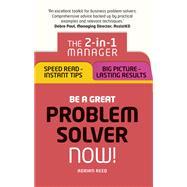Discover how to Be a Great Problem Solver - Now!
This 2-in-1 guide is designed to help you solve problems in an instant, whilst giving you the deeper knowledge to ensure long-lasting results.
With the unique 2-in-1 approach, you can learn your way. Use the 7 Speed Read tips immediately, then take your time exploring the Big Picture chapters.
· Analyse business problems and opportunities objectively and effectively to generate a range of possible solutions
· Avoid falling into the trap of selecting the first solution that seems feasible
· Understand how to work collaboratively with co-workers and stakeholders
· Use a one-page ‘Problem Canvas’ to scope out and explore a problem
As an ambitious manager, you need the right information at the right time to help you advance in your career. ‘The 2-in-1 Manager’ will ensure you improve and succeed in business, right now and in the future.








